
Every time I log in to LinkedIn, it looks a little bit more like a digital magazine. I’ve even started to visit the site not to tweak my resume or LinkedIn stalk my dream job, but to find articles to read and share. Between LinkedIn Today, the Influencers program and the redesigned mobile app, the platform is making major strides toward becoming a legitimate source for business news.
What can your brand learn from the platform that makes money as a recruitment tool but walks and talks like a news site? Let’s take a closer look.
1. Start with real business goals
As a professional social network, LinkedIn struggles to compete with Facebook and Twitter’s daily visitors and time on site. But since ore visitors means more data for their recruitment products and ultimately more ad dollars, frequent visitors are key to their revenue stream. Somewhere along the line, they decided content was the way to lure these visitors in.
Takeaway: Everyone is talking about content these days, but before you commit to a program like LinkedIn’s, you need to figure out what it is you want that content to accomplish. More visitors? More leads? User-generated content? Figure this out first, then build your program around it.
2. Bring in the influencers
In October LinkedIn introduced its Influencers program, which puts over 250 business leaders front and center to share their ideas. From Richard Branson to Guy Kawasaki, influencer isn’t just a kitschy name; members of this exclusive group actually wield significant influence in their respective industries.
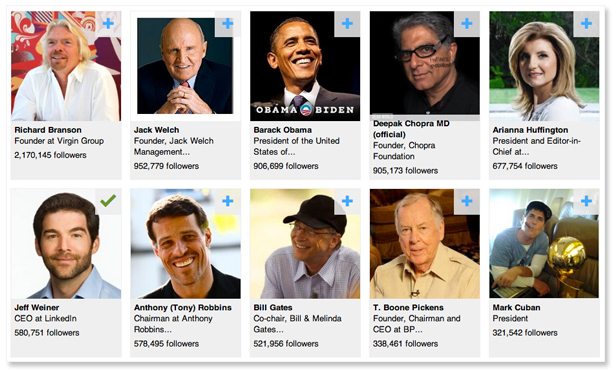
Takeaway: Influence matters. Tap into your personal network and ask the experts you know to lend their voice to your content platform.
3. Don’t drown them in ads
In the first quarter of 2013, advertising generated about a quarter (23%) of the platform’s total revenue. Building a content platform is expensive, so ad revenue is important — but that doesn’t mean your users want to be pelted with ads around every corner. LinkedIn does a nice job of balancing ads with organic content. Just take a look at this side-by-side comparison of advertising on Facebook versus advertising on LinkedIn.
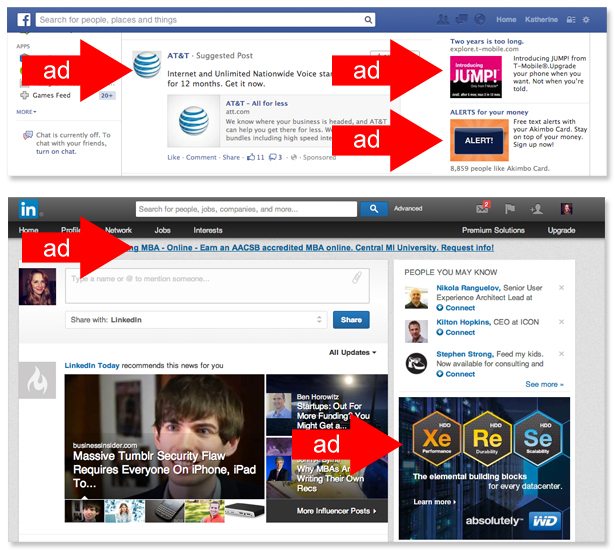
Takeaway: Ads pay the bills, but keep your user in mind. Make sure advertising spots don’t outweigh valuable content.
4. Be more than mobile friendly
In April LinkedIn rolled out a significant update to its mobile app. Several tweaks were made in this version, but most significantly, content now looks absolutely stunning on a smartphone. Every time I pull up LinkedIn on my iPhone, I think, “man, this is really beautiful.” The Top Stories widget up top offers teasers of curated content, and below it, links shared by my network really pop in the feed.

Takeaway: By now we all know content should be optimized for mobile. But a truly remarkable mobile experience puts content front and center and keeps users coming back for more.
5. Change the lens
One of the things I appreciate most about LinkedIn is that there are countless ways to discover content. I can follow an influencer like Michael Lazerow and see what he is writing and reading. I can follow a company to see what they’re sharing. I can jump to LinkedIn’s channel screen and select the topic I’m interested in reading more about.
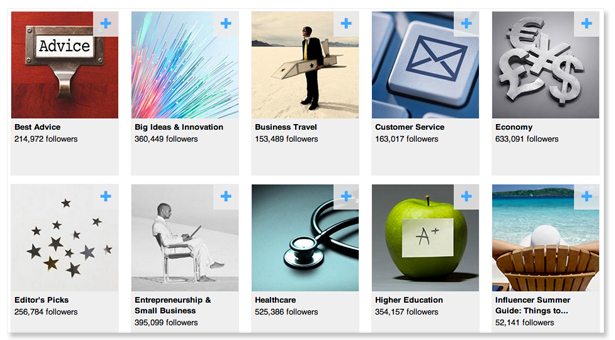
Takeaway: Give visitors options on how they can discover your content. Maybe it’s a “most shared” widget in your blog sidebar, or putting content categories front and center on your homepage. Users should have the ablitiy to navigate your content in new and interesting ways.
6. Ways to start the conversation
LinkedIn is packed with content to read, but they’ve also made a point to provide opportunities for visitors to participate. Groups are the old school (and in most cases unbearably spammy) version of this, but LinkedIn is constantly thinking of new ways for users to engage. Anyone can comment on an influencer’s status, and the new mentions feature makes it easier than ever to start a conversation.
Takeaway: Two-way platforms are great sources of user-generated content, and can keep the conversation momentum going longer.
7. Different content formats
In May of this year LinkedIn launched rich media updates to allow companies and users share images, documents and presentations as updates.
Takeaway: Is the best way to get your message across through a 1,000 word article, or could you say it better in a video, Slideshare deck or infographic? Remind yourself not to get stuck in a rut with content format.
8. Creation and curation
Sure, LinkedIn keeps users on site by directing them to influencer posts hosted on their blog. But there’s also the “LinkedIn today recommends” section, which features links that point to a variety of publications around the web.
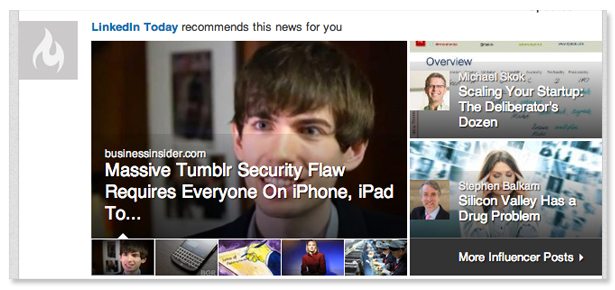
Takeaway: Content curation diversifies your brand’s voice and breaks up the monotony of promoting your own articles. Plus, this is content that you don’t have to actually sit down and write.
9. Don’t underestimate the power of email
There’s plenty of content on LinkedIn’s homepage, but if account holders never log in, they’re never going to see that content. LinkedIn pulls these less frequent visitors in with regular email alerts about new influencer posts. The email is simple — a personal call out in the subject line, plus an image of the influencer and quick teaser of the post. The call to action is clear: a big yellow button that reads, “View post.”
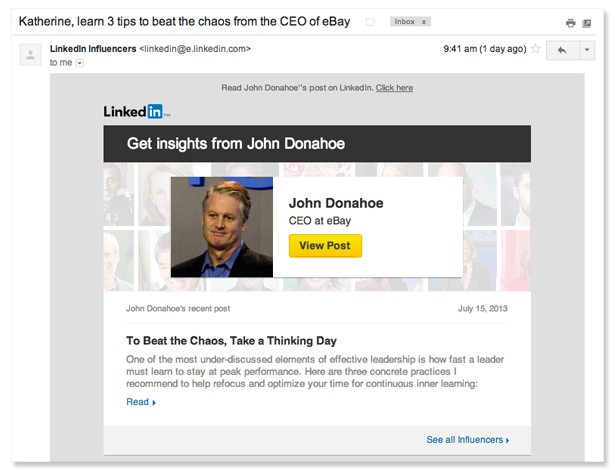
Takeaway: If you have great content, consider sharing it with your audience via email — it’s more personal and direct than a tweet or Facebook post.
10. Never stop improving the content experience
Probably the biggest lesson content producers can learn from LinkedIn’s media evolution is to never stop tweaking the experience. Jeff Weiner and team roll out a new content-focused feature what seems like every week, and the company has acquired a number of applications with the goal of improving the content experience.
Takeaway: You might not be able to acquire an application a month or roll out new products at LinkedIn’s level, but even small tests, tweaks and experiments can keep your brand’s content experience fresh.